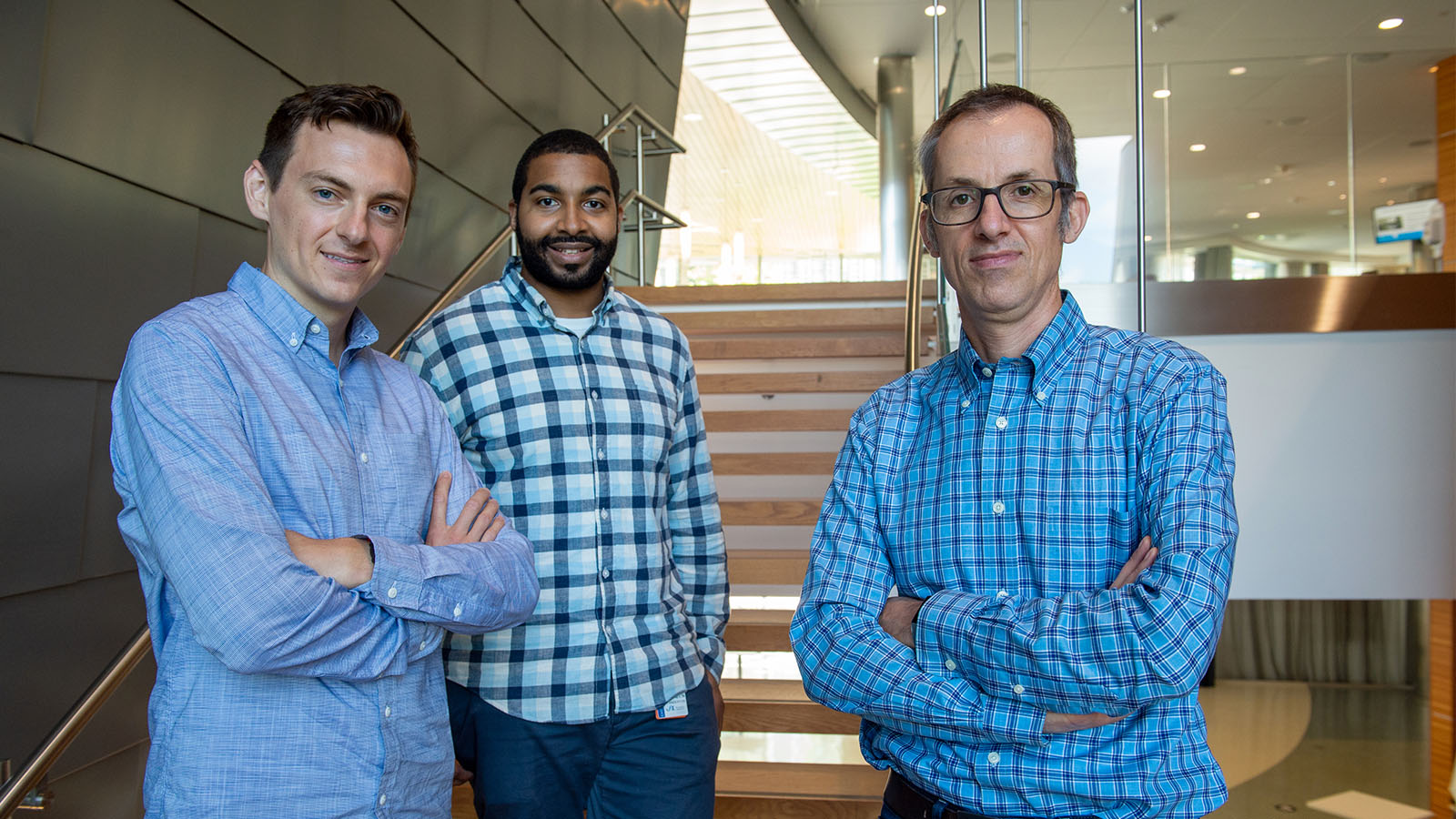 The JAX research team featuring (L to R) Kevin Johnson, Kevin Anderson, and Roel Verhaak. Photo by Cloe Poisson.
The JAX research team featuring (L to R) Kevin Johnson, Kevin Anderson, and Roel Verhaak. Photo by Cloe Poisson.
Gliomas, malignant brain tumors, are considered incurable by current science. What, then, makes them so adaptable and dangerous?
Diffuse gliomas are the most common malignant brain tumors in adults. Extensive research has revealed the genetic drivers of glioma and distinct tumor types, but these brain tumors display universal therapeutic resistance and inevitably recur. As a result, gliomas remain incurable. What, then, makes glioma cells so adaptable and dangerous?
Understanding why gliomas are so adaptable
It’s been recognized for years that glioma tumors are highly heterogeneous, meaning that individual cells within a single tumor can have different properties. It’s an important characteristic, as a therapy that kills one sub-class of cells might not work on others, leading to the resistant cells becoming dominant. The situation is further complicated by the fact that glioma cells are “plastic,” in that a single cell can reversibly transition between different sub-classes. To better understand how the cells become so adaptable, Jackson Laboratory (JAX) Professor Roel Verhaak, Ph.D., Research Scientist Kevin Johnson, Ph.D., and Postdoctoral Associate Kevin Anderson, Ph.D., led a team that looked beyond genetic mechanisms in its research. Instead, they focused on a layer of genetic regulation that can be altered in cancer: epigenetics.
It was previously known that epigenetic reprogramming can occur in glioma cells to facilitate a transition from a therapeutically vulnerable to resistant state following chemotherapy. However, the precise mechanisms that promote cellular plasticity and resistance remained poorly understood. In “Single-cell multimodal glioma analyses identify epigenetic regulators of cellular plasticity and environmental stress response,” published in Nature Genetics, the research team present findings after studying aberrations in the placement or removal of a particular epigenetic modification, DNA methylation (DNAme), in glioma cells. DNAme, in which a methyl group (a chemical modification) is attached to DNA, provides an important regulatory mechanism that helps determine when and to what extent specific genes are expressed with no change to the DNA sequence itself. The researchers wanted to understand how alterations to DNAme patterns in gliomas contribute to cellular plasticity within tumors and help explain therapeutic resistance.
Researching brain tumors on a genetic level
Verhaak and his team worked closely with neurosurgeons at UConn Health in Farmington, Conn., and St. Michael’s (Toronto) to obtain tumor tissue from 11 glioma patients. They used innovative single-cell methylation profiling methods with parallel single-cell gene expression and bulk tumor profiling to deeply analyze the patient samples. They also used carefully controlled in vitro research techniques to validate the findings from the primary tumors. They discovered that increased local DNAme disorder in tumor cells, a phenomenon where normal DNAme patterns are progressively disrupted, was elevated in more aggressive tumors. Investigating specific pathways, they found greater DNAme disorder in cell identity and stress response regulators that points to the adoption of distinct epigenetic states needed to tolerate harsh tumor environments. Perturbing glioma cell lines in vitro, they found that subjecting the cells to stress—low oxygen and irradiation—increased DNAme disorder throughout the epigenome and was linked with cell state changes. External stressors were also shown to generate specific DNAme changes that provided adaptive features responsive to cellular stress.
Overall, the work shows that DNAme disorder provides a mechanism for overcoming cellular stress such as therapy, increasing plasticity and enhancing treatment resistance. The study’s results also provide insight into the multitude of factors, including genetic and epigenetic, that combine to shape glioma cell identity and tumor heterogeneity. Further studies will be needed to understand exactly how increased DNAme disorder affords cells competitive advantages under stress, including cytotoxic therapies. Overall, the study uncovered epigenetic heterogeneity at an unprecedented resolution, providing valuable knowledge about how gliomas evade therapy that may, in turn, lead to more effective treatments.